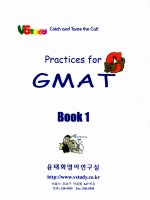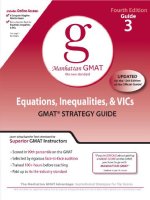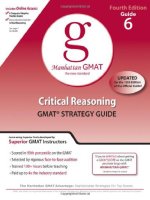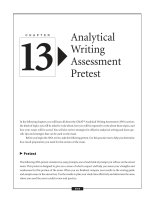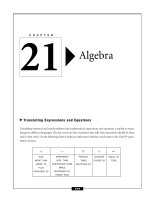Veritas prep GMAT geometry
Bạn đang xem bản rút gọn của tài liệu. Xem và tải ngay bản đầy đủ của tài liệu tại đây (10.29 MB, 206 trang )
Brian Galvin
Chris Kane
Geometry
Authors
Brian Galvin
Chris Kane
Co-founders
Markus Moberg
Chad Troutwine
Contributing Writers
David Newland
Ashley Newman-Owens
Contributing Editor
Jodi Brandon
Cover Design
Nick Mason
Interior Design
Tom Ahn
Dennis Anderson
ALL RIGHTS RESERVED. Printed in the U.S.A.
Third Edition, Copyright © 2013 by Veritas Prep, LLC.
GMAT® is a registered trademark of the Graduate
Management Admissions Council, which is not affiliated with
this book.
No part of this publication may be reproduced, stored in
a retrieval system, or transmitted in any form or by any
means, electronic, mechanical, photocopying, recording, or
otherwise without the prior written permission of Veritas
Prep, LLC.
All the materials within are the exclusive property of Veritas
Prep, LLC. © 2013.
Print Batch 2013.1
This book is dedicated to Veritas Prep’s instructors, whose enthusiasm and experience
have contributed mightily to our educational philosophy and our students’ success.
It is also dedicated to the teachers who inspired Veritas Prep’s instructors. The lesson
that follows was only made possible by a lifelong love of learning and of undertaking
educational challenges; we have teachers around the world to thank for that.
Finally and most importantly, this book is dedicated to our thousands of students, who
have taught us more about teaching and learning than they will ever know. And to you,
the reader, thank you for adding yourself to that group.
Personal Dedications
Veritas Prep is a community of educators, students, and support staff, and these books
would not be possible without our cast of thousands. We thank you all, but would like to
specifically acknowledge the following people for their inspiration:
Bogdan Andriychenko (GMAT Club), Clay Christensen (Harvard Business School), Tom
Cotner (Plymouth-Salem High School), David Cromwell (Yale School of Management),
Henry Grubb (Fort Osage High School), Dana Jinaru (Beat the GMAT), Steven Levitt
(University of Chicago), Walter Lewin (Massachusetts Institute of Technology), Lawrence
Rudner (Graduate Management Admissions Council), Jeff Stanzler (University of
Michigan), and Robert Weber (Kellogg School of Management).
TABLE OF CONTENTS
LESSON PREVIEW . . . . . . . . . . . . . . . . . . . . . . . . . . . . . . . . . . . . . . . . . . . . . . . . . . . . . . . . . . 7
SKILLBUILDER . . . . . . . . . . . . . . . . . . . . . . . . . . . . . . . . . . . . . . . . . . . . . . . . . . . . . . . . . . . . 13
LESSON. . . . . . . . . . . . . . . . . . . . . . . . . . . . . . . . . . . . . . . . . . . . . . . . . . . . . . . . . . . . . . . . . . 53
Geometry: Leveraging Assets . . . . . . . . . . . . . . . . . . . . . . . . . . . . . . . . . . . . . . . . . . . . . . . 53
Geometry and the Veritas Prep Pyramid. . . . . . . . . . . . . . . . . . . . . . . . . . . . . . . . . . . . . . . 54
SECTION 1: GEOMETRY STRATEGY . . . . . . . . . . . . . . . . . . . . . . . . . . . . . . . . . . . . 55
Leveraging Assets............................................................................................................57
GMAT Geometry Cheat Sheet......................................................................................58
SECTION 2: TRIANGLES . . . . . . . . . . . . . . . . . . . . . . . . . . . . . . . . . . . . . . . . . . . . . . . 60
Essential Properties of Triangles................................................................................. 60
Right Triangles...................................................................................................................61
Isosceles Triangles............................................................................................................65
Equilateral Triangles........................................................................................................67
Similar Triangles................................................................................................................71
External Supplementary Angles.................................................................................73
Triangles Summary..........................................................................................................76
SECTION 3: QUADRILATERALS . . . . . . . . . . . . . . . . . . . . . . . . . . . . . . . . . . . . . . . . 77
Essential Properties of Quadrilaterals........................................................................77
Quadrilaterals and Triangles.........................................................................................79
Defining Properties of Quadrilaterals........................................................................81
Diagonals............................................................................................................................83
Border Problems...............................................................................................................85
Quadrilaterals Summary................................................................................................87
SECTION 4: CIRCLES . . . . . . . . . . . . . . . . . . . . . . . . . . . . . . . . . . . . . . . . . . . . . . . . . . 88
Essential Properties of Circles...................................................................................... 88
Basic Circle Properties.....................................................................................................89
Circles and Inscribed Angles.........................................................................................91
Shapes Within Shapes.....................................................................................................93
Unusual Circle Figures.....................................................................................................97
Circles Summary.............................................................................................................. 99
table of contents
SECTION 5: COORDINATE GEOMETRY . . . . . . . . . . . . . . . . . . . . . . . . . . . . . . . . 101
Essential Properties of Coordinate Geometry..................................................... 101
Graphing Lines in the Coordinate Plane................................................................ 103
Mapping Figures in the Coordinate Plane............................................................ 105
Coordinate Geometry Summary.............................................................................. 108
SECTION 6: 3-DIMENSIONAL FIGURES. . . . . . . . . . . . . . . . . . . . . . . . . . . . . . . . 109
Essential Properties of Common 3-D Shapes...................................................... 109
Common 3-D Figures.................................................................................................... 111
Unusual 3-D Figures......................................................................................................112
Dimensional Figures Summary..................................................................................115
SECTION 7: YOU OUGHTA KNOW . . . . . . . . . . . . . . . . . . . . . . . . . . . . . . . . . . . . . . 116
Third Side Rule.................................................................................................................117
Greatest Distance Between Two Points Shortcut................................................119
More on Unique 3-D Shapes.......................................................................................121
Data Sufficiency and Geometry................................................................................ 123
Problems in Which Figures Are Not Drawn to Scale...........................................131
Geometry as a Vehicle for Hard Algebra................................................................133
HOMEWORK PROBLEMS. . . . . . . . . . . . . . . . . . . . . . . . . . . . . . . . . . . . . . . . . . . . . . . . . 135
Answer key. . . . . . . . . . . . . . . . . . . . . . . . . . . . . . . . . . . . . . . . . . . . . . . . . . . . . . . . . . . . 191
CR E ATING Think Like the Testmaker
Creating is the top of the pyramid in Bloom’s Taxonomy. When you have completely mastered the
GMAT, you are able to Think Like the Testmaker. You are on top of the pyramid looking down! You
don’t just have good content knowledge and lots of practice with GMAT problems; you understand
how a problem has been made, what makes it hard, and how to break it down. When you Think Like
the Testmaker you can:
1.
Quickly recognize what the problem is actually asking,
2.
Discover hidden information and manipulate it to make it useful,
3.
Recognize and see through trap answers, and
4.
Create your own plan of attack for any problem.
APPLYING Skills Meet Strategy
What makes the GMAT difficult is not so much the underlying skills and concepts, but rather the way
those skills and concepts are tested. On the GMAT, what you know is only as valuable as what you
can do with that knowledge. The Veritas Prep curriculum emphasizes learning through challenging
problems so that you can:
1.
Learn how to combine skills and strategies to effectively solve any GMAT problem,
2.
Most effectively utilize the classroom time you spend with a true GMAT expert, and
3.
Stay focused and engaged, even after a long day in the office.
R E M E M BE R ING Skillbuilder
In order to test higher-level thinking skills, testmakers must have some underlying content from
which to create problems. On the GMAT, this content is primarily:
•
Math curriculum through the early high school level, and
•
Basic grammar skills through the elementary school level.
To succeed on the GMAT you must have a thorough mastery of this content, but many students
already have a relatively strong command of this material. For each content area, we have
identified all core skills that simply require refreshing and/or memorizing and have put them in
our Skillbuilder section. By doing this:
1.
Students who need to thoroughly review or relearn these core skills can do so at their
own pace, and
2.
Students who already have a solid command of the underlying content will not become
disengaged because of a tedious review of material they’ve already mastered.
preview
PREVIEW
preview
As you learned in the Foundations of GMAT Logic lesson, the educational philosophy at
Veritas Prep is based on the multi-tiered Bloom’s Taxonomy of Educational Objectives,
which classifies different orders of thinking in terms of understanding and complexity.
To achieve a high score on the GMAT, it is essential that you understand the test from
the top of the pyramid. On the pages that follow, you will learn specifically how to
achieve that goal and how this lesson in particular relates to the Veritas Prep Pyramid.
7
How This Book Is Structured
Our Curriculum Is Designed to Maximize Your Time
The Veritas Prep Teaching Philosophy: Learning by Doing
Business schools have long featured the Case Method of education, providing students
with real-world problems to solve by applying the frameworks they have studied. The
Veritas Prep Learning by Doing method is similar. In class, you will spend your time
applying skills and concepts to challenging GMAT problems, at the same time reviewing
and better understanding core skills while focusing your attention on application and
strategy. The Case Method in business school maximizes student engagement and
develops higher-order thinking skills, because students must apply and create, not just
remember. Similarly, the Learning by Doing philosophy maximizes the value of your
study time, forcing you to engage with difficult questions and develop top-of-thepyramid reasoning ability.
An important note on Learning by Doing: In business school, your goal with a
business case is not to simply master the details of a particular company’s historical
situation, but rather to develop broader understanding of how to apply frameworks
to real situations. In this course, you should be certain to reflect on each question not
simply through that narrow lens (Did you answer correctly? What key word made the
difference?), but rather as an example of larger GMAT strategy (How could the exam
bait you with a similar trap? How deeply do you need to understand the content to
solve this genre of problem more efficiently?).
8
preview
How This Book Is Structured
As you learned in the Foundations of GMAT Logic lesson, there are
important recurring themes that you will see in most GMAT problems:
•
•
•
•
•
•
•
Abstraction
Reverse Engineering
Large or Awkward Numbers
Exploiting Common Mistakes
Selling the Wrong Answer and Hiding the Correct Answer
Misdirection
Content-Specific Themes
Skills M eet Strategy
•
•
•
Guiding Principles
Problem-Solving Strategies
Leveraging Assets
9
preview
Th in k Like th e Testmaker
remember : Don’t mistake
activity for achievement!
Focus on recurring themes,
not just underlying content.
Each book in the Veritas Prep curriculum contains four distinct sections:
1.Skillbuilder. We strongly suggest that you complete each Skillbuilder
lesson before class at your own pace, and return to the Skillbuilder when you
recognize a content deficiency through practice tests and GMAT homework
problem sets.
The Skillbuilder section will:
•
Cover content that is vital to your success on the GMAT, but is best
learned at your own pace outside the classroom.
•
Allow you to review and/or relearn the skills, facts, formulas, and content
of the GMAT. Each student will have his own set of skills that are “rusty” or
even brand-new, and will find other items that come back quickly.
•
Vary in length significantly for each book, based on the number of
underlying concepts. (For instance, the Advanced Verbal lesson does
not have a Skillbuilder because you are already building on the concepts
introduced in three previous lessons.)
2.Lesson. The lessons are designed to provide students with maximum value
added from an instructor by:
•
Doing in-class problems together (Learning by Doing), and
•
Analyzing those problems for the recurring takeaways.
With each problem, there will be a detailed explanation that will help you
understand how the problem is testing a particular concept or series of
concepts, what makes the problem hard, and what underlying skills are
required to solve it.
When relevant, there will be particular boxes for Think Like the Testmaker,
Skills Meet Strategy, and Skillbuilder when you should be focused on
particular aspects of how the question is made or how the underlying
content is being tested.
N o te : When doing in-class and homework problems, you should do your
work below the problem, and you should not circle the answer on the
actual question (just note it on the bottom of the page). That way, if you
want to redo problems, you can simply cover up your work and proceed
as if you had never done it.
10
preview
How This Book Is Structured
3. You Oughta Know. The You Oughta Know sections will round out each lesson
and cover:
Obscure topics that arise infrequently.
•
More advanced topics that are not common on the GMAT but do get
tested.
While these uncommon content areas do not warrant in-class time, we
believe you should have some exposure to these topics before taking the
GMAT. Therefore you should complete these sections before moving to
the homework problems. As with the Skillbuilders, the length of these will
vary depending on their importance.
preview
•
4. Homework Problems. In many ways, the homework problems are the most
important part of each book. After refreshing core content in the Skillbuilder
and then applying that knowledge in the lesson, you must reinforce your
understanding with more problems.
Each question is accompanied by a detailed explanation in your online
student account, as well as a quick-reference answer key on the last page.
A majority of questions are above the 50th percentile in difficulty, and they
are arranged in approximate order of difficulty (easiest to most difficult). By
completing all of the homework problems, you will learn all of the different
iterations of how concepts and skills are tested on the GMAT.
Homework problems are designed to be challenging, so do not despair if
you are answering questions incorrectly as you practice! Your goal should
be to learn from every mistake. Students can miss a significant percentage of
questions in each book and still score extremely high on the GMAT, provided
that they learn from each problem. Embrace the challenge of hard problems
and the notion that every mistake you make in practice is one that you will
know to avoid on the GMAT when every question counts.
11
12
skillbuilder
Skillbuilder
skillbuilder
As you will see in the lesson to follow, GMAT geometry strategy can be best epitomized
by the phrase “leverage your assets.” Do you remember proofs from high school? To
solve a geometry problem, you must use small and seemingly unimportant pieces of
information—a length here, an angle there—to build a broader picture. This ability to
put together multiple pieces of information and leverage all the assets in a problem
is the core skill that the GMAT tests with geometry. Like a consultant restructuring a
company to attain a higher ROI, you must use cleverly hidden but fairly basic geometry
concepts to solve seemingly impossible problems. But you can’t leverage assets that
you don’t have, so in this Skillbuilder section you will see (and have an opportunity
to practice) the major rules, formulas, and concepts that you need to solve any GMAT
geometry problem.
13
Lines and Angles
When we refer to “lines,” we are describing straight lines that never alter direction.
Two lines that intersect form four angles, with two pairs of angles being identical on
opposite sides of the intersection. The sum of the two angles on one side of a line
always is 180°.
x°
y°
y°
x°
x°
y°
x°
y°
y°
x°
x° + y° = 180°
Parallel lines on a two-dimensional plane will never intersect.
Two perpendicular lines are at 90° to each other.
This symbol indicates that
the two lines are
perpendicular to each other.
14
y°
x°
skillbuilder
Example: Fill in the missing angles.
60°
Step 1. Two angles on the same side of a line add up to 180° 180 - 60 = 120
120°
60°
skillbuilder
Step 2. Two pairs of angles are identical on opposite sides of the intersection.
120°
60°
60°
120°
When two parallel lines are intersected by a third line, two sets of 4 identical angles are
created:
ℓ3
y° x°
x° y°
ℓ1
ℓ2
y° x°
x° y°
ℓ1 is parallel to ℓ2
15
While most students are comfortable with the concepts relating to lines and angles,
they frequently forget to apply these rules on complex problems. Consider the
following figure from a problem in a geometry book:
A
F
E
B
C
D
Note that angle CED is equal to angle AEF because of intersecting lines , and that angle
CDE equals angle EAF because of parallel lines intersected by a straight line. It is very
easy to overlook these facts and instead focus on other rules relating to triangles and
quadrilaterals.
16
skillbuilder
Lines and Angles Drill
Use the figure below to answer the following questions:
ℓ1
1
2
6
3
7
4
8
skillbuilder
5
ℓ2
1. If the measure of angle 2 is 77°, what is the measure of angle 5?
2. If the measure of angle 2 is 77°, what is the measure of angle 1?
3. What is the sum of the measures of angles 1, 2, 5, and 6?
4. If ℓl and ℓ2 are parallel and the measure of angle 8 is 104°, what is the
measure of angle 6?
5. If the measure of angle 1 is 97° and the measure of angle 7 is 83°, are ℓ1
and ℓ2 parallel?
6. If ℓ1 and ℓ2 are parallel and the measure of angle 4 is 65°, what is the
measure of angle 6?
7. If the measure of angle 6 is 109° and the measure of angle 7 is 73°, are ℓ1
and ℓ2 parallel?
8. If ℓ1 and ℓ2 are parallel and the measure of angle 1 is 90°, what are the
measures of every other angle?
17
Solutions
1. If the measure of angle 2 is 77°, what is the measure of angle 5?
77°
2.
If the measure of angle 2 is 77°, what is the measure of angle 1?
103°
3.
What is the sum of the measures of angles 1, 2, 5, and 6?
360°
4. If ℓ1 and ℓ2 are parallel and the measure of angle 8 is 104°, what is the measure
of angle 6?
104°
5. If the measure of angle 1 is 97° and the measure of angle 7 is 83°, are ℓ1 and ℓ2
parallel?
Yes
6. If ℓ1 and ℓ2 are parallel and the measure of angle 4 is 65°, what is the measure
of angle 6?
115°
7. If the measure of angle 6 is 109° and the measure of angle 7 is 73°, are ℓl and ℓ2
parallel?
No
8. If ℓl and ℓ2 are parallel and the measure of angle 1 is 90°, what are the measures
of every other angle?
90°
18
skillbuilder
Triangles
The sum of the angles in a triangle is always 180°, regardless of shape.
If you know two angles of a triangle you can always find the third angle:
We know a + b + c = 180.
a
If we are told that a is 70° and c is 50° then we can find b by
substituting the variables we know with their values.
b
c
70 + b + 50 = 180 → b = 180 – 70 – 50 → b = 60°
skillbuilder
The perimeter of a triangle is the sum of the length of its sides. P = a + b + c
5
7
Perimeter: 5 + 6 + 7 = 18
6
The area of a triangle is its base multiplied by its height divided by 2.
4
6
or
4
6
∙ h
A = b____
2
∙
4 = 12
Area: A = 6____
2
The height or altitude of a triangle is defined as the distance from the base to the
opposing apex. The altitude is always perpendicular to the base.
Any side can be the base, and the area is the same for all base/height combinations in
the same triangle. The longest side of a triangle is always the side opposite the greatest
angle. The shortest side of a triangle is always the side opposite the smallest angle.
19
Important Triangle Concepts:
1. Right Triangles: A right angle triangle (one angle equals 90°) allows us to
calculate the length of one side when we know the length of two other sides,
by using a2 + b2 = c2.
Right triangles are an integral part of geometry on the GMAT and must be
mastered by students. In this section we will look at some of the common
right triangles and how they are tested.
2. Right Triangles with Certain Sides: While students must be prepared to deal
with any combination of sides with right triangles, there are a couple specific
right triangles with whole number sides that are frequently used on the GMAT.
The right triangles below, with sides 3, 4, 5, and 5, 12, 13, are those commonly
used triangles. Note that the sides of these triangles may be any multiple of
the side given in these example (e.g. 6, 8, 10 or 2.5, 6, 6.5, etc.)
a = 3
3
?
b=4
Find c.
4
Because one angle is 90° we can use the Pythagorean Theorem: a2 + b2 = c2
Substitute the variables with their known values:
32 + 42 = c2 → 9 + 16 = c2 → 25 = c2 → c = 5
b = 12
?
13
c = 13
Find a.
12
Because one angle is 90° we can use the Pythagorean Theorem:
a2 + b2 = c2
Substitute the variables with their known values:
a2 + 122 = 132 → a2 + 144 = 169 → a2 = 169 - 144 → a2 = 25 → a = 5
20
skillbuilder
3. Right Triangles with Certain Angles: Two other very common right triangles are
ones with the angles 30, 60, 90 and 45, 45, 90. These triangles are unique because
you can determine all of the sides when only one side is given (traditional
pythagorean theorem requires that two sides are given).
4. 30-60-90 Triangles: A triangle with the angles 30, 60, and 90 always has sides
__
with lengths of the proportions 1, √
3, and 2. Note that 2x is the longest side,
so 2x belongs on the hypotenuse. Similarly, x is the shortest side and belongs
__
on the side opposite the 30° angle. x√ 3 , as the length of the medium side,
belongs opposite of the 60° angle.
60°
2x
skillbuilder
x
30°
x√ 3
60°
5
10
30°
5√3
Example: In the following two triangles give the value of side y.
1.2.
60°
y
y
30°
27
30°
√ 48
60°
__
In the first triangle we must divide the side opposing 60° by √
3 to determine
the short side (the side opposing 30°). After this division and removing the
__
root from the denominator we see that y = 9√ 3 .
In the second triangle, we must use the same procedure to determine the
___
__
short side, so we divide √
48 by √
3 and find that the short side is 4. We must
then double that to determine the hypotenuse, so y =8.
21
5. 45-45-90 Triangles (aka Right Isosceles Triangles): A triangle with the angles
__
45, 45 and 90, always has sides with lengths of the proportions 1, 1, and √
2 :
__
45°
x
__
45°
x√ 2
3√ 2
3
45°
45°
3
x
Example: In the following triangle, what is the value of side y?
45°
___
√
32
y
45°
y
To determine the short sides of a 45-45-90 triangle, we must divide the
__
hypotenuse by √ 2 .
___
___
√
32
32 = √___
__ = ___
____
16 = 4. Therefore y = 4 in this example.
2
√
2
√
A 45-45-90 triangle is simply one half of a square. Therefore when
determining the diagonal of a square, use the relationship you have learned
with the 45-45-90 triangle.
n o te :
22
skillbuilder
6. Isosceles Triangles: An isosceles triangle has at least two sides and two angles
that are the same.
When an altitude is drawn in an isosceles triangle from the unequal side, it
always creates two equal triangles. In other words, the altitude splits the base
and the angle evenly when drawn from the unequal side. In the following
diagram, isosceles triangle ABC is split by an altitude drawn from the vertex
at point B to point D on unequal side AC. Because of this rule we know that
AD = DC, angle ABD = angle DBC and triangle ABD is congruent (equal) to
triangle DBC.
B
skillbuilder
A
D
C
23
7. Equilateral Triangles: In an equilateral triangle, all sides are of equal length and
all angles are 60°.
60°
60°
24
60°
Since an isosceles triangle is one with at least two sides and two angles equal,
every equilateral triangle is also an isosceles triangle. Equilateral triangles are
very common on the GMAT and possess several important properties that
students need to memorize.
When you draw in the height of an equilateral triangle, two 30-60-90 triangles
are formed. Using the 30-60-90 ratios we just learned,
you can deduce that the
__
√ 3
___
height of an equilateral triangle will always be times the side of the triangle.
2
1 Base x Height.
As with all triangles, the area of an equilateral triangle is __
2
skillbuilder
Quadrilaterals
Quadrilateral literally means “four-sided”. The angles in a quadrilateral always add up
to 360°. The four most frequently encountered types of quadrilaterals on the GMAT are:
1.Square
a. Every side is the same length and opposite sides are parallel.
b. Every angle is 90°.
L
90°
90°
skillbuilder
L
L
90°
90°
L
Area: L2
Perimeter: 4L
2.Rectangle
a. Opposite sides are parallel and of the same length.
b. Every angle is 90°.
L
90°
W
90°
W
90°
90°
L
Area: L ∙ W
Perimeter: 2L + 2W
25
